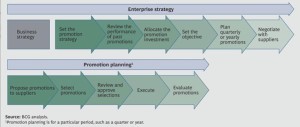Brick-and-mortar retailers—including supermarkets, discounters, drugstores, and mass merchandisers—rely heavily on promotions, which typically account for 10 to 45 percent of their total revenues. Although promotions are a powerful instrument for increasing sales and margin, they are also difficult to use effectively. One reason for this is a lack of clear insight into which promotions are working—and why. The Boston Consulting Group’s research indicates that 20 to 50 percent of promotions generate no noticeable lift in sales—or, worse, have a negative impact. Another 20 to 30 percent dilute margins in that they don’t generate an increase in sales sufficient to offset promotion costs.
To help retail companies run fewer, more effective promotions, we have developed a four-part approach to improving promotion planning, evaluation, and execution. By adopting these practices, companies can increase the margin on promotions by 2 to 5 percentage points and position themselves to win in an increasingly challenging retail environment.
An Overreliance on Promotions
Retailers face strong pressure to grow, and running promotions is a proven way to increase top-line sales. As a result, most retailers run thousands of promotions a year, past the point of diminishing returns. Even though many promotions lose money, retailers are hesitant to scale back the volume, primarily because they don’t know which ones are working. Running so many promotions, however, undermines their strategic potential: to create a competitive edge in a market.
Changes in the retail environment are only encouraging retailers to maintain the volume of promotions. Online retailers are taking business away from brick-and-mortar stores, which is evidenced by e-tailers’ compound annual growth rate of more than 20 percent since 2009, compared with only 4 percent for brick-and-mortar retailers. This disparity is likely to persist, and e-tailing’s share of the retail sector is expected to continue rising for the foreseeable future. Furthermore, digital promotions, such as those distributed through e-mail, mobile ads, and printouts from point-of-sale devices, are becoming more prevalent and increasing the complexity for retailers. For example, many retailers are being distracted by the potential for customized offers that target individual shoppers with unique promotions on the basis of their shopping history, preferences, and other factors. However, customized offers are still a remote prospect for most traditional retailers.
In such a challenging environment, retailers need to take systematic steps to improve the performance of their promotions. By doing so, they can improve their top line and bottom line—and distance themselves from the competition. Success requires starting with promotion basics: building a comprehensive strategy, advancing employees’ capabilities, and developing tools and processes to measure performance and to use that information to improve promotions over time. Our research indicates that if retailers fix the basics and better evaluate promotions, they can reduce the number of promotions that dilute margins—and especially sales—and increase the percentage of value-adding promotions. (See Exhibit 1.) Although digital promotions are one aspect of a more effective approach to promotions, they are not a cure-all. Spending on traditional media will remain a critical component of promotion for most retailers, until digital promotions mature.
In the article:
A Four-Part Solution
Craft a winning promotion strategy to guide category-level decisions
Deploy big-data analytics to produce actionable recommendations
HOW A CATEGORY MANAGER ANALYZED PROMOTION PERFORMANCE
A LARGE RETAILER RETOOLS ITS PROMOTIONS
Authors:
Americas: Nicholas Goad, Partner & Managing Director, Washington, DC; Jeff Robinson, Partner & Managing Director, Atlanta
Europe & Middle East: Javier Anta , Partner & Managing Director, Madrid; Andreas Malby , Principal, Copenhagen; Jacob Opstrup, Consultant, Copenhagen
Acknowledgments:
The authors thank Jeff Garigliano for his writing assistance and Katherine Andrews, Gary Callahan, Catherine Cuddihee, Kim Friedman, Abby Garland, John Kerr, Trudy Neuhaus, and Sara Strassenreiter for their contributions to the editing, design, and production of this report.
More: www.bcgperspectives.com
